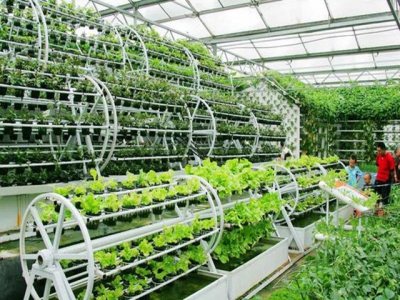Where is Vietnams hi-tech agriculture?

IoT and blockchain application in agricultural production in Vietnam remains modest, while other high technologies are used by only 10 percent of Vietnam’s agricultural production workforce.
IoT application in agriculture production remains modest
According to Phan Thai Trung from the Digital Agriculture Cooperative, high technologies applied in agricultural production in Vietnam include biotechnology; cultivation and preservation technologies; and automation and agriculture material production technologies. IoT and blockchain, called the ‘elements of the 4.0 industry revolution’, belong to automation category
Hi-tech agriculture is still the ‘playing field’ of large cooperatives and enterprises which have powerful financial capability, large production scale and modern governance skills.
Meanwhile, farming households, which account for 90 percent of Vietnam’s agricultural production workforce as reported by Forbes Vietnam in April 2018, still cannot ‘go modern’.
No one wants to utilize high technologies in small-scale production with low productivity, according to GIBC’s chair Pham Phu Ngoc Trai.
Dao The Anh, deputy chair of the Vietnam Science Association for Agriculture Development, at the 2018 Spring Agriculture Forum, pointed out a series of big problems in the stages of agricultural production chain, from the use of many workers, high post-harvesting losses to low added value.
Domestic production heavily depends on agricultural material imports. A senior executive of VinEco said to grow high-quality vegetables, the company has to import fertilizer and seeds because domestic supplies are not satisfactory.
Domestic production heavily depends on agricultural material imports. A senior executive of VinEco said to grow high-quality vegetables, the company has to import fertilizer and seeds because domestic supplies are not satisfactory.
The livestock industry cannot develop because everything must be imported, from animal feed to medicine.
In terms of technology, Pham S, deputy chair of Lam Dong province, said all the 4.0 equipment must be imported from Japan and the US at very high prices because the products cannot be made domestically.
Even big corporations are reluctant to spend money on high technologies.
Nguyen Dang Trieu Thien, CEO of Lina Network, a blockchain solution provider, said Lina has customers from Thailand and Laos, but no customers from Vietnam.
“Vietnamese enterprises are still thinking and are indecisive,” he said.
Nguyen Phuong Thao from VinEco said: “It is necessary to define what to produce, whom to target and which standards to be applied. The answers to the questions will help identify which technologies are needed.”
Enterprises are advised to implement hi-tech agricultural projects, because high technologies can bring very big benefits.
Thao said VinEco can have three to four vegetable crops in the north, but 10 crops if they grow vegetables in glasshouses in Lam Dong province.
Có thể bạn quan tâm
 Quang Tri offers incentives for businesses investing in high-tech agriculture
Quang Tri offers incentives for businesses investing in high-tech agriculture The central coastal province of Quang Tri has been adopting a number of preferential policies to attract investment in high-tech agriculture for the 2018-2021
 Việt Nam struggles to export fruit to demanding markets
Việt Nam struggles to export fruit to demanding markets Việt Nam has exported its fruit to high-standard markets in recent years, such as the US, the European Union and Japan, but increasing export volume is no easy
 Building brand name for Vietnam’s coffee
Building brand name for Vietnam’s coffee Vietnam is one of the largest coffee producers in the world, earning more than 3 billion USD from the export of coffee bean each year